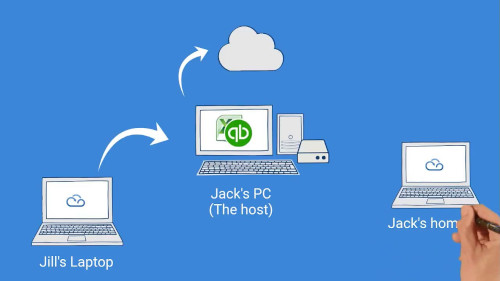With thousands of coronavirus cases across the globe, the dynamics of doing business are shifting at a very alarming rate. The lock-downs, social distancing, and quarantine measures being implemented are forcing businesses to rethink their working strategies.
Many have been forced to make a quick transition to remote work to keep the businesses going regardless of the available infrastructure.
Businesses are looking for ways to remain productive collaboratively and securely with limited face-to-face interactions.
The most recent report from CDC indicates more than 7000 people are infected across the 50 states. By mid-February, over 46% of American companies had implemented a remote work policy.
Presently, companies are seeing the need to develop strategies that will help them cope with any similar future situations immediately.
Remote-work has proven to be an efficient disaster proof continuity plan for businesses globally. Businesses that invest time and infrastructure now will reap the best rewards in the long run, when working in offices is thing of the past.
Coronavirus could be the catalyst to make remote work the norm.
COVID-19 has shifted the narrative of remote work from the future of work to the present. Over the past ten years, remote work has grown by 91%.
According to Flexjobs, 85% of businesses report an increase in productivity thanks to the flexible schedule. Also, 80% of remote workers reported less stress levels and 90% of them say remote jobs increase their morale.
Not only that, but employees are ready to get a pay cut if it means they will work remotely.
While working from home is beneficial to both employers and employees, a lot of companies lacked the technology and infrastructure required to transition without sacrificing some business operations.
The one prominent COVID-19 outcome is the need for businesses to fast-track digital transformation.
Some of the challenges companies have faced when developing remote-work policies include:
- Maintaining a sense of connection and communication.
- Supporting the staff who feel excluded and isolated.
- Choosing the best technology that will boost collaboration, innovation, and security.
- Maintaining business continuity and productivity.
Key elements should remote-work strategies address
To successfully adopt a remote-first perspective, companies need to look at their entire business model and roles played by each person.
1. Know who remote work applies to
Some roles are more suitable for distributed teams than others. Companies have to have a clear outline of these roles. For instance, lay down the protocol for the employees that have to access the office, get new equipment to keep track of projects, or make adjustments to the team’s priorities during shutdowns.
2. Data protection
All the remote staff need access to data for their workflow. How do you maintain data protection within the short transition period? Additionally, all staff doesn’t need to access the same data. Different security access levels have to be maintained. Sensitive, confidential, and private data access by everyone will bring the company down.
Map out the data requirements and consider using security measures that are quickly implemented. Virtual private network (VPN) or remote solutions like MyQuickCloud can be quickly put in place.
3. Employees goals, expectations and performance
Distributed teams focus more on results than time spent working. Managers need to shift how they measure their employee performance. Companies should implement a results-oriented work environment for their employees as it empowers them to be accountable and in control of their schedules.
A study by Owl Labs in 2019 proved that employees are 79% more productive and focused with this remote-work policy.
4. Availability of equipment and space for remote work
Business continuity and workflow is affected when employees aren’t equipped to work from home. Do they have laptops, mobile phones, and internet access? Or ideal work spaces?
5. Communication and collaboration of teams
Good communication is a determinant factor in effective collaboration for a remote team. Create communication spaces, pay attention to the communication channels, and set expectations. Use technology tools that are easily accessible like Slack, Zoom, Skype, Google Hangouts, G-suite, among others.
The benefits of remote-work
- Good health
The amount of viruses we spread around while working under one roof has never been more evident. Office complexes bring numerous people closely together exposing them to whatever virus going around.
A report by Robert Half in October 2019 said 90% of American workers go to work when they are sick. Remote work provides a controlled work environment for everyone.
- Business continuity
With remote teams, you don’t have to wait for everyone to be in the building for some processes to progress. The employees that rely on others collaborate with them from wherever they are located.
Also, in lock-down situations, operations continue efficiently without disruptions.
- Expansion of remote learning
Businesses, schools, and universities have turned to virtual learning options. Companies have made it possible for employees to attend seminars through video conferencing and webinars. Conferences and seminars are trillion-dollar sectors that have been majorly impacted by the virus.
Businesses have had to think outside the box for alternative options while maintaining public safety.
Schools and universities also realized the need for virtual learning. With some universities like Harvard Business School already having an online platform, others were closed down completely to contain the spread.
- Business contingency plan
Organizations with flexible work schedules in place have a seamless transition to remote work. Their operations haven’t been paralyzed by the pandemic.
Companies have to create a remote-working capacity to serve as a business contingency plan.
- Business recovery
Business disruptions caused by coronavirus have evidenced the need for alternative ways to do business. Remote work empowers companies to overcome disruptions and recover much more quickly.
Their employees are still being productive regardless of their location.
How to get started on a remote-work strategy
Companies without a remote work policy are making it clear that they care less about disruptions and their employees. The big tech giants such as Amazon, Twitter, Google, Facebook, and Microsoft have already implemented remote work guidelines to almost all their employees.
COVID-19 has accelerated remote work with over 20 million remote workers across the USA and the EU.
So, how can your company implement a remote-work strategy now?
MyQuickCloud is a one-stop-shop for all your remote working needs. It equips companies with a cost-efficient platform that is secure, saves on-boarding time, and keeps all your operations running.
With a few clicks, your remote workers can access all the resources they need to do their work from your business private cloud.
Sign up for a free trial to access your entire IT infrastructure remotely.





